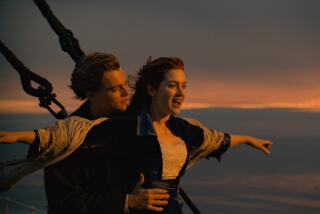Young Explorers Get a Robotic-Eye View of Undersea Wonders : Education: Man who located wrecks of Titanic and Bismarck lands in Dana Point to boost research vessel, show students the marvels of marine science.
- Share via
DANA POINT — Enthusiastic shouts from schoolchildren in another room learning about the ocean interrupted famed marine explorer Robert D. Ballard, discoverer of the sunken ships Titanic and Bismarck. But Ballard loved it.
“How many classrooms encourage kids to scream?” Ballard said during an interview Friday at the Orange County Marine Institute at Dana Point Harbor.
What with overpopulation, rampant pollution, diminishing natural resources and advancing technology, the teaching of science is more important than ever, he was saying when the shouts interrupted him.
“Kids are born scientists. They ask why. They ask why until about the sixth grade, when we beat it out of them not to ask anymore. But we have to keep the wonder alive. How? By showing them wondrous things.”
Ballard, senior scientist at the Woods Hole Oceanographic Institute in Massachusetts, was in Dana Point to endorse the Marine Institute’s latest project: a research and education boat being built which will be able to explore the ocean floor using the same robotic technology Ballard used to discover the two sunken ships. The Titanic was found in 1985, and the Bismarck was discovered only two years ago.
A hint of what lies ahead for the Marine Institute vessel, to be named the R/V Sea Explorer, was demonstrated Friday night when two divers equipped with a camera broadcast pictures from the ocean floor to a “telepresent” gathering of Marine Institute benefactors a mile away at the Dana Point Resort.
Two television screens showed the divers 41 feet below in a kelp forest battered by a surging current and hindered by poor visibility. A bright yellow Garibaldi fish swam past, sea urchins were glimpsed tucked between rocks, and one of the divers caught a young horn shark and held it in front of the camera.
With a few exceptions, the adults in the room paid more attention to the hors d’oeuvres and bar. But five schoolchildren in a corner did not take their eyes off the screen as they went on a video scavenger hunt, watching for sea animals and plants that the divers found with the camera.
“This is the kids’ technology base,” Ballard said, explaining the students’ interest. “They’re very involved with what’s going on down there on the bottom of the ocean, even with this tremendous distraction,” he said, referring to the cocktail party.
The key to teaching science to children is to “have a hook,” Ballard said. “You’ve got to get them in the room.”
When the R/V Explorer sends a robot into the ocean and sends back pictures to children in a classroom, the students can’t help but be excited, he said.
“It’s sort of like ‘Star Trek’--beam me down. Except you have to go to the room to be beamed.”
All students need to be excited by science, not just those who eventually will go into scientific disciplines, he said. Yet, the traditional way to teach science is to weed out the less smart and concentrate on the future scientists, he said.
“Anyone can pick up a crab and get excited about it,” he said. “The formal classroom is a failure. . . .
“The focus should not be on the gifted child. It should be on the ungifted child.” He pointed out that 92% of all prison inmates are high school dropouts.
“I’d rather invest in education than in prisons.”
Employing his sophisticated robotic vehicle Jason, which was used to discover the sunken ships, Ballard has developed the “Jason Project,” an education program for children in the sixth through 10th grades.
The kids, gathered in various “telepresent” centers across the nation, actually get to maneuver the robot on explorations. (The Orange County Marine Institute is hoping its R/V Sea Explorer facility will become part of the Jason Project.) “We say, ‘Do you want to drive the robot that discovered the Titanic?’ There’s not a kid around who doesn’t want to. Then we say, ‘You have to study science for four months,’ ” Ballard said. The kids are hooked.
This year, the Jason Project is going to enable schoolchildren to explore the Galapagos Islands. The environment there is so fragile that only 30,000 people a year are permitted to visit. “But through electronic travel, we can take 600,000 kids there. That’s a 20-year quota,” and there will be minimal damage to the environment, he said.
Ballard pointed out there are more people living today than ever before. “As affluent Americans, we are the role model for the world but we are not a good one,” making up 5% of the world population but consuming 40% of its resources.
“Technology is a two-edged sword,” he said. Nuclear energy produces electricity but an accident could bring disaster. Computers allow people to bank from their homes but can let others invade privacy. Plastic can be made into wonderful things, but it fills up landfills, he said.
“We are constantly plagued with technological problems. Society has to be literate enough to be aware of what it can do.”
He believes the robotic technology used to discover the Titanic and make it accessible to 600,000 schoolchildren eventually will “lead right to your house,” allowing people to explore places--perhaps even outer space--from their own telepresent theaters.
“I’m building one of those theaters in my home. In the next 10 years, I expect to do my exploring at home and then go out and play with my kids.
“I’d rather explore than travel,” he said. “I’ll be able to get a bottle of Chardonnay and go to the moon.”
More to Read
Sign up for Essential California
The most important California stories and recommendations in your inbox every morning.
You may occasionally receive promotional content from the Los Angeles Times.













